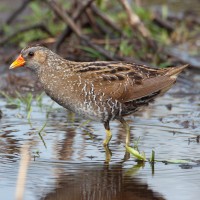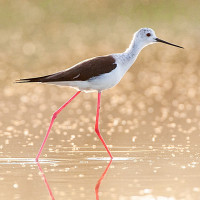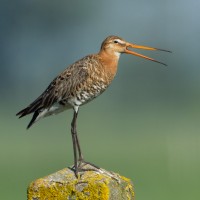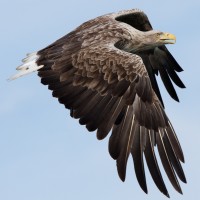Description
Its rich and diverse habitats, most of it protected, create a safe place to forage and breed. Lots of herons in the heronry in summer, including the rare Eurasian Spoonbill and most summers Great Bittern. But it is the reedbed birds that are the real prices here: Sedge Warbler, Reed Warbler, Savi's Warbler, Cetti's Warbler, Bluethroat, Bearded Tit, Western Marsh Harrier all breed here. Lots of ducks and shorebirds, including one of the last strongholds of Black-tailed Godwit and Eurasian Curlew can be seen displaying. The area also holds Common Quail, Spotted Crake and Water Rail and in wet years sometimes Corn Crake can be heard! The park and scattered Poplar stands still hold Golden Oriole and lots of warbler species as well.
In 2024 the area saw two nesting White-tailed Eagle. The first successful breeding attempt in Belgium.
In winter 1000s of geese (mostly Greater White-fronted Goose, but also increasingly Tundra Bean Goose and Barnacle Goose) winter amongst 10000s of Eurasian Wigeon, Northern Shoveler, Common Teal and many more. Great Egret come to roost in the willows and both Hen Harrier and Western Marsh Harrier sleep in the large reedbeds.
Many (local) rarities have been found including Baillon's Crake, Pygmy Cormorant, Squacco Heron, Marsh Sandpiper, Red-throated Pipit, Penduline Tit and Aquatic Warbler and many more in recent years. Every other year there is a Lesser White-fronted Goose or Red-breasted Goose in the region. Pallid Harrier and Osprey halt on their migration. In short: there is always something worth seeing in this remarkable nature reserve managed by Natuurpunt.
Details
Access
There are quite a few ways to get to the best birding spots. Recently a new gateway to the best places is being build and new watch towers are already in place. The route shown on the map is about 10 km, but of course you can choose to do only a part.
Best way is to enter via the main visitors gate along the Iepersteenweg from Diksmuide to Ieper. It is easily found when you look for the park with large trees when you exit the village of Woumen on your right. There is a visitors centre where you can find an update on the latest sightings, get a map or ask questions (and have a coffee or another drink).
Terrain and Habitat
Forest , Wetland , Scattered trees and bushes , Grassland , Valley , Reedbeds , Mud flats , LakeConditions
Flat , Wet , Open landscapeCircular trail
YesIs a telescope useful?
Can be usefulGood birding season
All year round , Spring , WinterBest time to visit
Spring migration , Spring , WinterRoute
Paved road , Unpaved roadDifficulty walking trail
Average walkAccessible by
FootBirdwatching hide / platform
YesExtra info
Stay on the paths and trails. In the late autumn through winter and early spring, it can be muddy so wellies are then a must have.
Check https://westland.waarnemingen.be/ for the latest sightings and location of the most interesting birds and other wildlife. See the link below.



.jpg)
